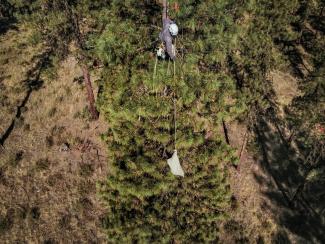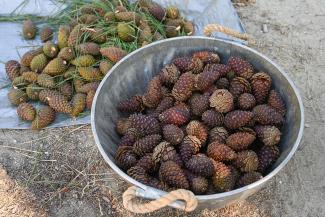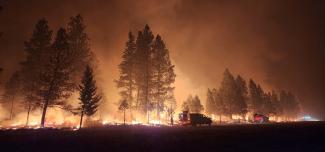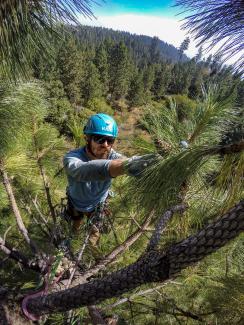Saving Seeds
Traveling Tree Climbers Harvest Ponderosa Pine Cones As Wildfire Grows Near
Lindsey Winkel, Intermountain Region Public Affairs Specialist
December 9th, 2024


Matt Todd traveled from the Beaverhead-Deerlodge National Forest to harvest pine cones on the Boise National Forest for their seed bank. USDA Forest Service photo by Monica Vermillion.
“Head-aaaaache!” Keith Wilson yelled as a branch fell 75 feet down from the crown of a ponderosa pine tree. He was at the top, tied in by a harness, picking pine cones.
“That’s what you yell before a branch breaks, or you throw something down,” he said. “It’s a smokejumper thing.”

Keith Wilson just descended from picking cones in a ponderosa pine tree on the Boise National Forest. USDA Forest Service photo by Lindsey Winkel.
Smokejumpers get certified to climb trees in case their gear gets stuck when parachuting to remote sites on a wildfire assignment. Wilson is not a smokejumper, but he learned to climb trees from smokejumpers 10 years ago and eventually became an instructor himself. Now he’s the tree climbing coordinator for the USDA Forest Service Intermountain Region. As a silviculture technician, he was climbing ponderosas to harvest cones for the Boise National Forest’s seed bank.
Eight other climbers were in the trees around him, hidden by their branches. If it weren’t for other employees on the ground wearing hard hats and waiting for a sack of cones to be lowered down, you wouldn’t know anyone was overhead. The crew worked like squirrels, picking, sorting, and measuring pine cones by the bushel to send to Lucky Peak Nursery in Boise.

Ponderosa pine cones get sifted from twigs and needles and measured into a bushel container before going to Lucky Peak nursery. USDA Forest Service photo by Lindsey Winkel.
With multiple timber sales and thousands of acres burned by wildfire, the Boise has an active reforestation program. They monitor natural tree regeneration to determine how many trees need to be planted to restore a healthy landscape, but they need seeds to grow seedlings. Acquiring seed is not as simple as a catalog order. Ponderosa pines don’t produce cones every year, and it’s never certain when they will. Pollinated cone buds aren’t big enough to be visible until around June, and sometimes insects make a meal of the maturing cones as soon as the seeds start to develop inside.
The cones need to be carefully monitored for viability as they ripen, which typically happens by the end of August. It is an unpredictable and small window of opportunity to determine whether a crop can be collected and then organizing the skilled labor that can do the work. This year, the Boise National Forest got lucky with a bumper crop of both.

A silviculturist inspects an embryo, a future tree, from a dissected seed to check maturity before harvesting the cone from a ponderosa pine tree. USDA Forest Service photo by Lindsey Winkel.
“The silviculture department realized we had a huge crop this year but initially were skeptical we would be able to take advantage of this potentially once-in-a-career opportunity,” said Adam Lulu, silviculture forester and tree climber. “We were amazed by the amount of support and assistance we received from people across the forest and within multiple regions.”
By mid-summer the word spread that it would be a good cone year, and a roster of more than 30 Forest Service tree climbers from across the nation committed to helping the Boise harvest.

Climbers from the Forest Service Southeast Region traveled to Idaho with all of their gear, including hooks to help them reach the end of long branches. USDA Forest Service photo by Lindsey Winkel.
At that point, it was a waiting game for the cones to ripen, but in the late evening of July 24, lightning struck in Grandjean, Idaho. As the Wapiti fire grew, tree climbers weren’t sure if they would be able to pick the cones before the fire reached their collection sites.
“A lot of the northern Boise National Forest was closed from all of the fires,” said Brian Krupitzer, silviculture forester. “The fact that we could still access these areas and pick cones was lucky. The last cone crop we had was in 2020, and even then, it was just a small area.”

Wapiti firefighters worked to suppress spot fires that crossed Highway 21. USDA Forest Service photo by Kyle Miller.
Climbers knew that any day the collection areas could be closed if the fire reached them. The Wapiti fire grew to 129,000 acres across the Boise and Sawtooth National Forests, but only one collection area near Lowman, Idaho burned and was closed off.
After three weeks of harvesting, the Boise National Forest collected 1,374 bushels of pine cones. Lulu said he anticipates that will yield more than 1,500 pounds of seed. That could yield as many as 5,250,000 seedlings, or more.

Joe Baer, tree climbing coordinator for the Northern Region, cuts the stem of a pine cone from high atop a ponderosa pine. USDA Forest Service photo by Lindsey Winkel.
“To put into perspective how large this project was, in the past 10 years we have used over 2,200 pounds of ponderosa pine seed to plant trees on the forest,” Lulu said. “In the same timeframe we have only been able to collect approximately 542 pounds”.
When the Repairing Existing Public Land by Adding Necessary Trees Act was signed into law in 2021 , Congress mandated that the backlog of National Forest Land acres in need of reforestation be addressed within 10 years. The Boise National Forest expects to meet their target of planting over 2,100 acres next year. They anticipate 3,000 more acres will need to be planted in 2026. Lulu credits the efforts of all the climbers and ground support and says it will help sustain the Forest’s reforestation program for many years.
The National Forest land that was burned from the Wapiti fire will need to be monitored over the next few years to determine how much replanting is needed to properly restore it, but this year’s bumper crop sets them up for better success.
“A lot of our local community lost their traditional hunting grounds, hunting stands, and camping sites that their families have enjoyed for generations. All they saw us doing was shutting off areas, and they had to breathe in the smoke,” Wilson said. “For many of us tree climbers, we need them to know that we do care, and yes, we will be restoring the forest so that their children and grandchildren can enjoy it in future generations.”


